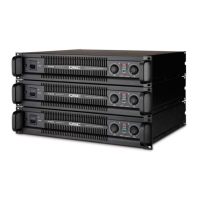PL3 Series Service Manual 37
TD-000274-00 Rev. A
Excessive distortion: Each channel should exhibit midband
(approx. 1 kHz) THD of 0.01–0.02% at output levels between about
50 W and 500 W (about 20–63 V rms) into 8 ohms, increasing to
about 0.2% just below clipping and above about 5 kHz. A slight
oscillation or “glitch” in the distortion trace at about 1 to 2 dB below
clipping is normal but should not exceed 0.2%. Running signals on
the opposite channel should affect THD only slightly.
• Try each channel individually at full power (testing both channels
simultaneously will draw too much power, causing limiting).
Switching in a 4-ohm load should cause only a slight reduction in
the voltage at which the amplifier clips. After several seconds,
the gain may cut back to reduce power supply current below
about 35 A (120 V) or 18 A (230 V). Typical midband THD at 10 dB
below full power will reach 0.04–0.05%.
• Switch the load to 2 ohms. You should observe about 4000 W
(approx. 89 V rms or 126 V peak) power for about 1 to 1.5
seconds, with an AC draw of about 60 A (120 V) or 30 A (230 V).
The gain should then reduce fairly quickly to about 2500 W
(approx. 70 V rms or 100 V peak), with an AC draw of about 35 A
(120 V) or 18 A (230 V). Typical midband THD at 10 dB below full
power will reach 0.1%.
• Moderate distortion problems could be caused by incorrect dead
time.
Turn-on noise (DC offset) problems: On channel 1, resistors R23,
R309, and R17 (schematic: see sheet
“AMP CH-A, PL380”
zone B-7)
provide feedback from the modulator output to op amp U3:2 during
muting, keeping the feedback voltages approximately where they
belong so there is no large jump when muting ends.
On channel 2, the equivalent components are resistors R194, R368,
and R189 and op amp U27:2 (schematic: see sheet
“AMP CH-B,
PL380”
zone B-7 and C-7).
If these resistors are missing or incorrect, the channel output may
have DC offsets in excess of ±50 mV, as well as turn-on thumps.
Instabilities are indicated by continuous or intermittent bursts of
high-frequency oscillation or noise in the audio signal. Check these
items:
• Disconnect the load, disable the clip limiter, and drive the
channel into clipping with a 1 kHz signal. You may observe slight
ringing on the clipped waveform, but no gross oscillations or
cutback.
• Put a 6 kHz square wave signal into the channel input and with
the load still disconnected, adjust the gain or signal level to get
about 50 to 60 volts on the output. Observe the output signal on
the oscilloscope.
Switch an 8 ohm load resistance onto the output, then 4 ohms
and 2 ohms. You should observe only slight changes of leading
edge and overshoot as the loads are changed.
3.1 PL380: Symptoms, causes, and remedies (continued)
With no load, the output may show one or two cycles of damped
ringing after the square wave leading edge. If you increase the
signal or the channel gain to nearly the point of clipping, the
peaking may become excessive, resulting in the amp limiting or
muting to protect against severe overshoot.
• The amplifier’s frequency response is set by C2 and C200
(schematic: see sheet
“AMP CH-A, PL380”
zone B-8), which are
set to produce flat frequency response out to 20 kHz. The phase
shift of the 2-pole output filter will result in about 10% peaking
on the square wave’s leading edges.
• Stability compensation components include C10 with R13, C16
with R32, C13 with R25, R22, and C17 (schematic: see sheet
“AMP CH-A, PL380”
zone B-7). Components R35, R36, and C21
must also be correct.
Abnormal clipping behavior: At just below clipping, you may
notice some switching behavior that looks like a slight oscillation on
the output. This is normal for the class of modulator used in the
PL380 amplifier, and it should not increase THD beyond about
0.25%. It also should not increase greatly when the channel clips
with no load, which is the most severe test of the amplifier’s
stability.
If the switching behavior becomes chaotic with no load or the THD
climbs severely at higher powers, first check all the stability
components: C10 with R13, C16 with R32, C13 with R25, R22, and
C17 (schematic: see sheet
“AMP CH-A, PL380”
zone B-7). Also
check the soft-clip circuit, D68 and D108 (zone C-6), and the
reference threshold system Q80, Q81, R369–R372, R148, and R391
(schematic: see sheet
“AMP CH-B, PL380”
zone C-7).
Zobel network: An RC damping network (schematic: see sheet
“AMP CH-A, PL380”
zone A-2) across the output, comprising C78
(0.47 µF) with 100-watt resistors R85 and R86 (20 ohms, mounted on
the heat sink). This maintains a 10-ohm load on the amplifier at high
frequencies, but the resistors could still be overloaded by excessive
HF output energy. If this happens, as the power dumped into the
resistors exceeds their wattage ratings, bus ZOB-A triggers Q4 via
R33, and pulls up on the LIMITER-A bus, reducing the overload. This
constrains long-term, 20 kHz power to about 900 W into 8 ohms,
which should not interfere with any reasonable audio usage.
A second, fast-acting muting scheme with C224, R383, R384, and
Q83 (schematic: see sheet
“AMP CH-A, PL380”
zones A-6 and A-7)
mutes the amp within 15 ms if it detects runaway HF behavior, such
as no-load operation above 40 kHz.
If the zobel resistors fail, the amplifier may function okay into test
loads but will limit prematurely at all frequencies because voltage
will pass through C78 and trigger the limiter. The fast muting is
meant to protect the zobel resistors.
Frequency response and gain issues: The amplifier’s frequency
response is set by C2 and C200 (schematic: see sheet
“AMP CH-A,

